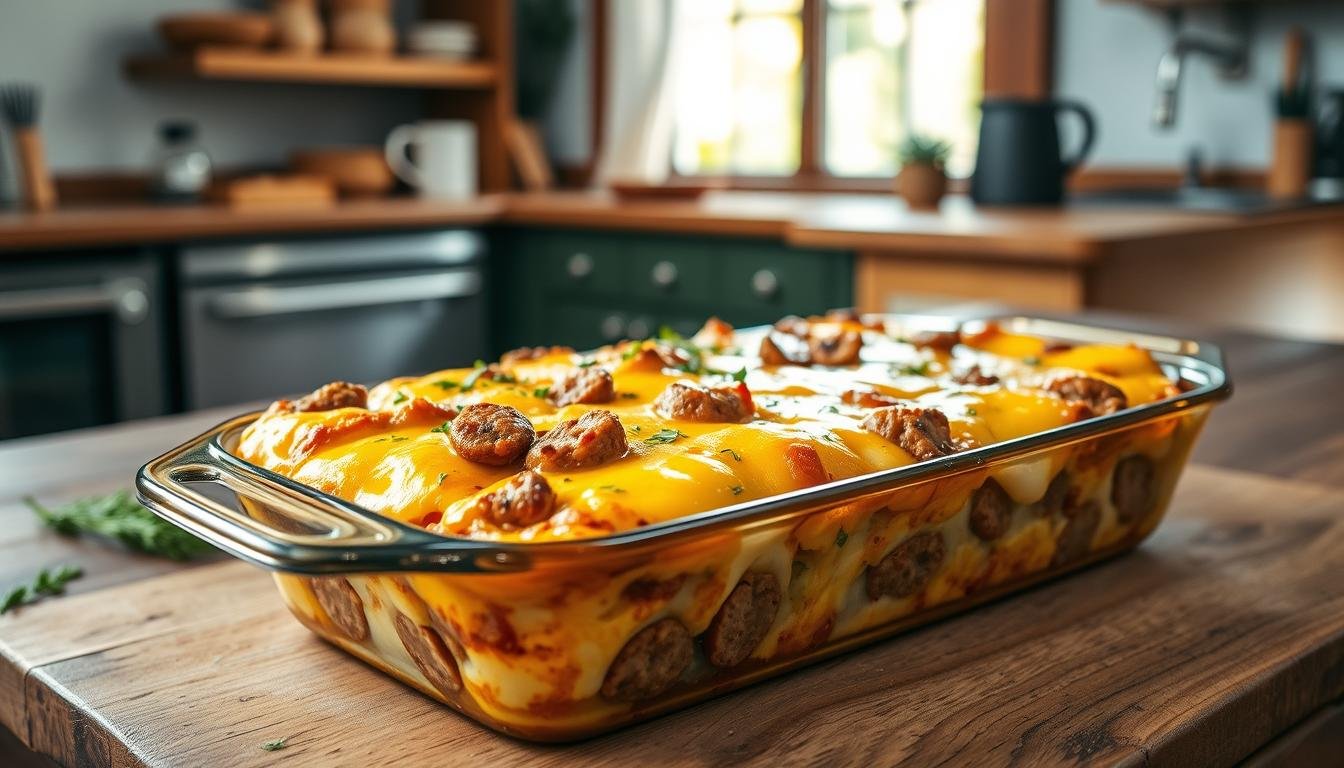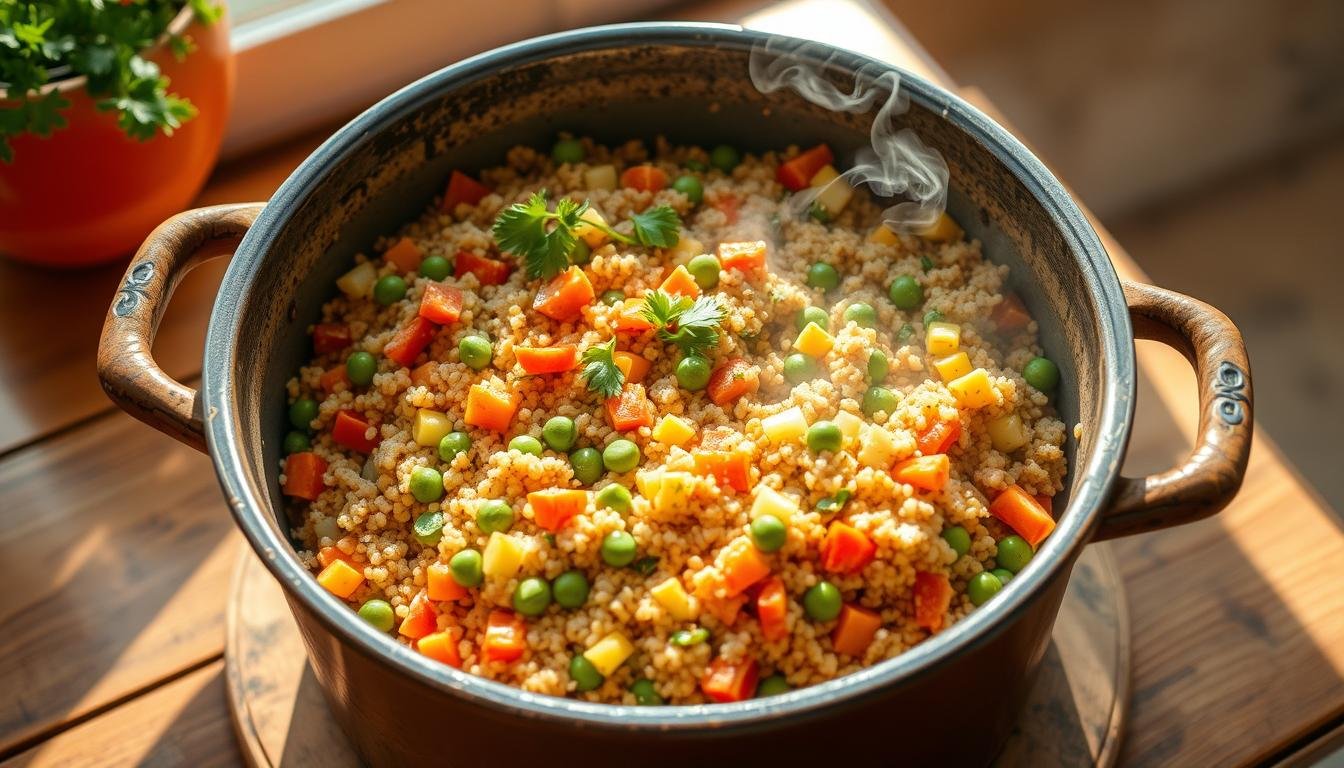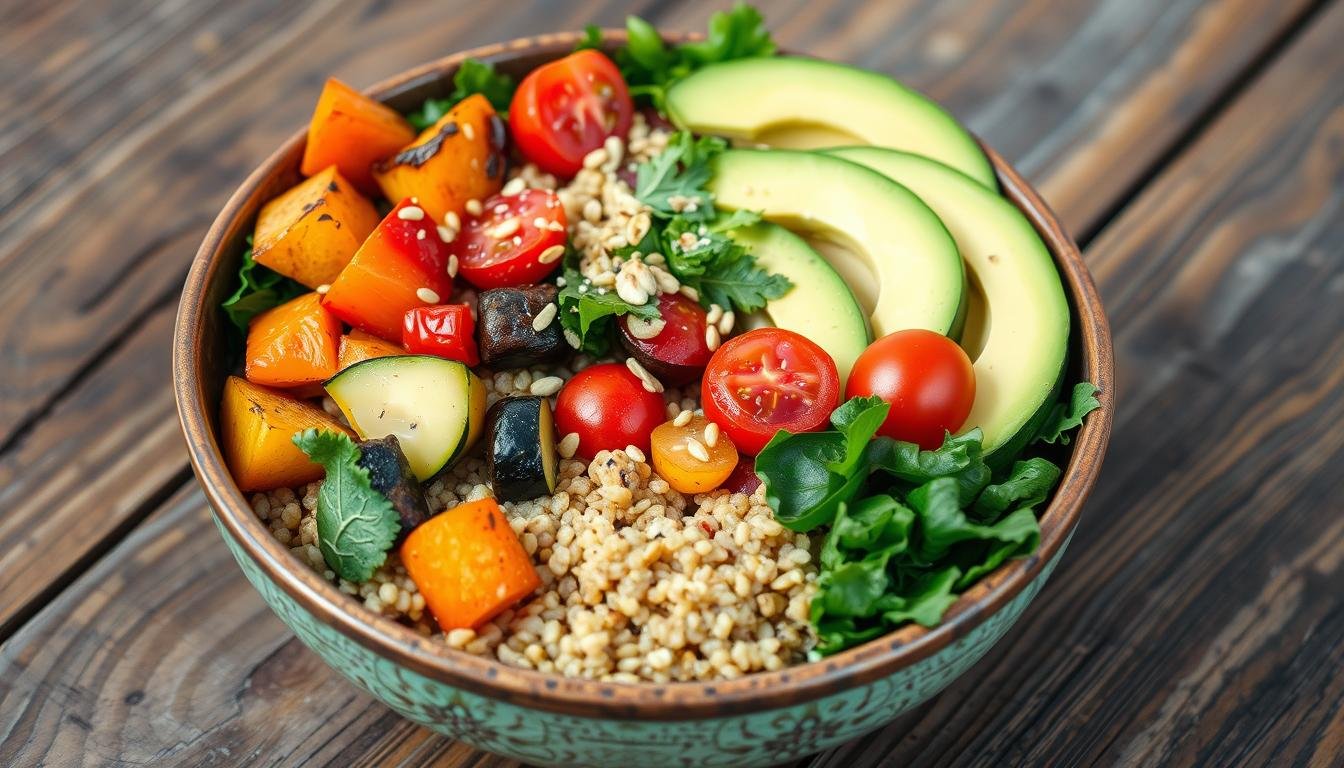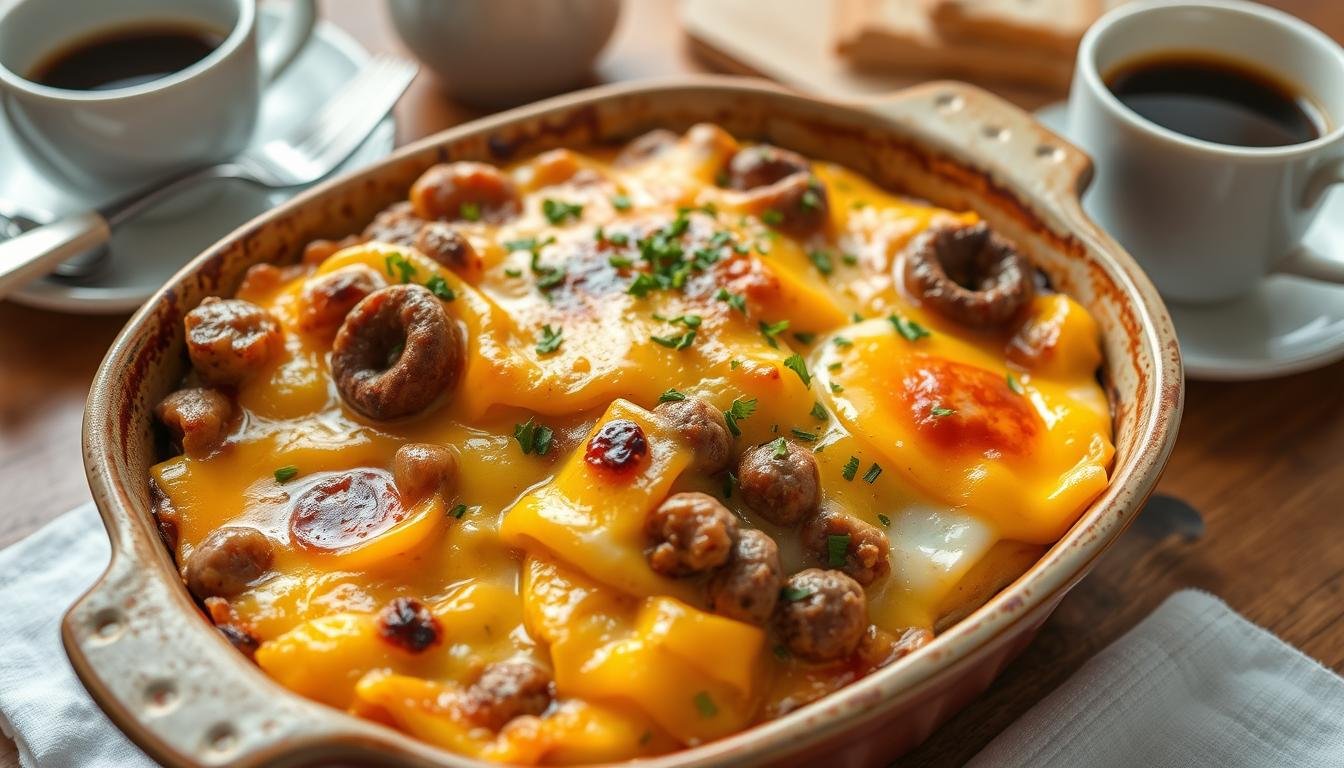Looking for a delicious, hearty meal to start your day? Try this savory sausage and cheese casserole recipe. It’s a mix of rich flavors and easy preparation, perfect for breakfast or brunch. With savory sausage, creamy cheese, and more, it’s a dish that will please everyone.
Introduction to Savory Sausage and Cheese Casserole
The Savory Sausage and Cheese Casserole is a mix of tradition and modern taste. It’s a homemade casserole loved at family gatherings and holiday meals. It’s hearty, comforting, and easy to make, loved by many.
This dish is perfect for any time, from Sunday brunch to holiday mornings. It combines savory sausage, creamy cheese, and a crescent roll crust. It’s packed with protein, making it a satisfying choice.
Making this casserole is easy, which is a big plus. It serves 8 people, great for family meals or small gatherings. It cooks in about 55 minutes at 350°F, until it’s golden brown. You can prepare it ahead of time, letting the flavors blend for a richer taste.
Plus, you can customize it to your liking. Try different cheeses or herbs to make it your own. This makes the Savory Sausage and Cheese Casserole a go-to for creative breakfast ideas.
In short, this casserole is more than a meal; it’s a comforting presence at breakfast. It’s versatile for any occasion and loved by all. It’s a standout in the world of easy breakfast recipes and homemade casseroles.
Ingredients for the Perfect Breakfast Sausage and Cheese Casserole
Creating a delicious breakfast like the Savory Sausage and Cheese Casserole starts with top-notch ingredients. This recipe has a mix of essential and optional items. It lets you make a breakfast that’s just right for you.
Core Ingredients
The main parts of this casserole are key for its great taste and texture:
- Eggs: Use 6 to 10 eggs for a good mix. They add protein and help hold the dish together.
- Breakfast Sausage: One pound of savory breakfast sausage gives a hearty flavor.
- Cheddar Cheese: Two cups of shredded cheddar cheese make the dish creamy and delicious.
- Bread: Bread cubes soak up the egg mix, making a great base.
- Milk: Two cups of milk make the casserole creamy and smooth.
- Salt: A little salt boosts all the flavors.
Each serving of this casserole is packed with 356 calories, 21 grams of protein, and 27 grams of fat. For more details and instructions, check out our recipe on Tastes Better from Scratch.
Optional Add-ins
For a more personalized casserole, try these optional add-ins:
- Mushrooms: Freshly sliced mushrooms add an earthy flavor and a touch of luxury.
- Bell Peppers: Diced bell peppers bring vibrant color and a mild sweetness.
- Green Onions: Chopped green onions add a mild, zesty bite.
These add-ins let you customize your casserole to fit different tastes and diets. They can turn a classic breakfast casserole into a special dish. Whether it’s for a family breakfast or a holiday meal, these options make it memorable.
Step-by-Step Instructions
Making a tasty sausage and cheese casserole is easy with clear steps. This guide will help you from start to finish, ensuring a great dish every time. Learning how to make a casserole boosts your cooking skills and gives you a hearty meal. Follow these steps for a perfect casserole.
Prepping the Ingredients
First, gather all needed ingredients and tools. You’ll need a 9×13-inch baking dish and a 12-inch skillet. Here’s what you’ll need:
- 1 pound of Italian sausage, cooked and crumbled
- 6 large eggs, beaten
- 2 cups shredded cheddar cheese
- 1.5 cups whole milk
- 5 ounces fresh baby spinach, roughly 5 cups
- 1/2 cup chopped sun-dried tomatoes
- 1 small red onion, diced
- 3 cloves garlic, minced
- 1/3 cup sour cream
- 1 tablespoon Dijon mustard
- 1/2 teaspoon salt
- 1/2 teaspoon pepper
Assembling the Casserole
Layering is key in making a casserole. Preheat your oven to 350°F (175°C). Grease your 9×13-inch baking dish. In a skillet, sauté the onion and garlic in unsalted butter until fragrant. Add the sun-dried tomatoes and baby spinach, cooking until wilted. Spread this mixture evenly in your baking dish.
Next, layer the cooked sausage on top of the vegetable mixture. In a separate bowl, whisk together the eggs, milk, sour cream, Dijon mustard, salt, and pepper. Pour this egg mixture over the layers in your baking dish. Top with shredded cheddar cheese. Make sure to distribute the ingredients evenly to avoid clumping or uneven cooking.
Baking Directions
Place the casserole in the preheated oven and bake for 35-40 minutes. Check it at the 30-minute mark to ensure even cooking. The top should be golden brown, and a knife inserted in the center must come out clean. If the top browns too quickly, cover it with aluminum foil for the remaining baking time.
Once baked, let the casserole rest for a few minutes before serving. This allows the layers to set properly, giving you neatly sliced pieces. Store any leftovers in the refrigerator for up to 2 days or freeze for up to 2 months. For more recipes, check out Sausage, Egg, and Cheese Breakfast Casserole.
By following these steps and understanding casserole preparation, you can serve a delightful and satisfying meal. Enjoying a homemade casserole is a testament to your culinary efforts.
Pro Tips for Making a Flavorful Casserole
Making a tasty casserole needs careful steps, especially with breakfast sausage and cheese. Here are some expert tips to make your dish perfect every time.
Tips for Cooking Sausage
Getting your breakfast sausage right is key. Start by heating your skillet over medium heat. This helps the sausage brown evenly. Crumble the sausage in the pan to cook it for about 5 minutes.
Once it’s brown and almost cooked, drain the fat. This keeps your casserole from being too greasy.

- Brown evenly: This ensures the taste is the same throughout.
- Drain excess fat: It prevents the dish from being too greasy.
- Season well: Add garlic or onions for more flavor.
Cheese Selection Tips
Choosing the right cheese is crucial. It should match the other flavors and add creaminess. Shredded cheddar is popular, but mixing cheeses can add depth. Think about how well the cheese melts. Cheeses like mozzarella and Monterey Jack melt well, making your casserole smooth.
| Cheese Type | Flavor Profile | Meltability |
|---|---|---|
| Cheddar | Sharp and tangy | Excellent |
| Monterey Jack | Mild and creamy | Excellent |
| Gruyere | Nutty and salty | Good |
- Shredded cheese: Homemade shredded cheese melts better.
- Blend cheeses: Mix cheddar and mozzarella for great melt and taste.
- Measure accurately: Use about 8 ounces of cheese for 10 large eggs.
Follow these tips to make your sausage and cheese casserole delicious. It will be a hit at any meal.
Why Make-Ahead Breakfast Casseroles Are a Game Changer
A make-ahead breakfast casserole is a game changer for breakfast. It’s simple and practical, making mornings easier. This dish is great for busy mornings and big groups.
Convenience for Busy Mornings
Imagine waking up to a meal ready to go. This is what a make-ahead breakfast casserole offers. It’s prepared ahead, making mornings calm and enjoyable.
It can be refrigerated overnight or frozen for months. This flexibility makes meal prep easy. It’s perfect for stress-free holiday mornings.
Having a ready-made dish saves time. It’s great for getting kids to school or starting a busy workday. For more tips, check out Savory Sausage and Cheese Breakfast Casserole.
Perfect for Holidays and Gatherings
Make-ahead breakfast casseroles are perfect for holidays and gatherings. They serve 12 people, making them ideal for big groups. They’re great for Thanksgiving, Christmas, or brunch.
You can customize them with leftovers or low-carb options. This makes them perfect for different tastes. They can be baked the night before or just before serving.
They keep their flavor and texture well, even after refrigeration. Reheating at 350°F for 30-40 minutes keeps them delicious. For more on making this dish, visit Savory Sausage and Cheese Breakfast Casserole.
In short, make-ahead breakfast casseroles are a big win. They make mornings easier, holidays more enjoyable, and are perfect for any group. For more details, check out Savory Sausage and Cheese Breakfast Casserole.
Customizing Your Casserole
Making a breakfast casserole for everyone’s taste is easy. You can make it vegetarian or gluten-free with simple steps. This way, everyone can enjoy a delicious meal.
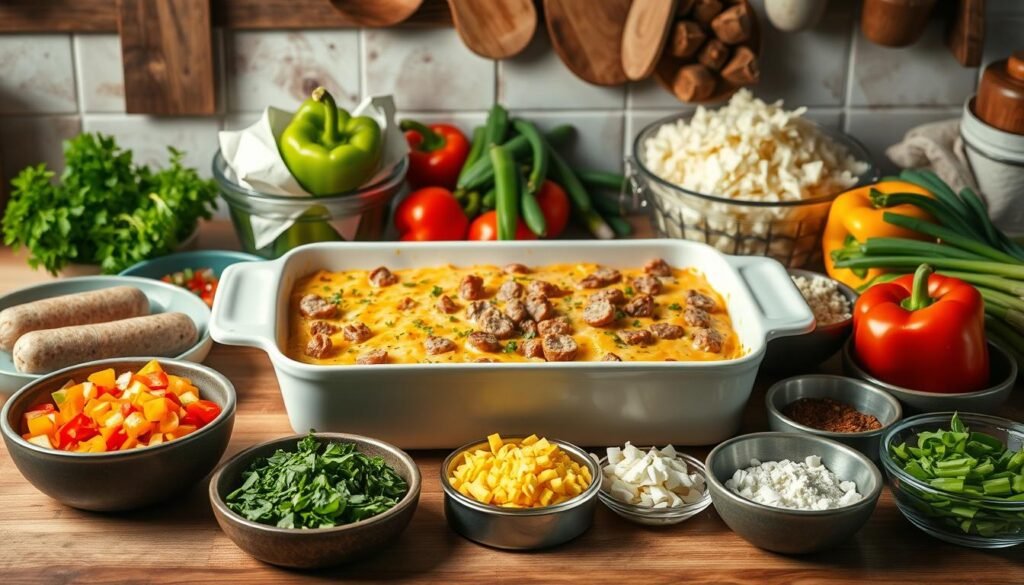
Vegetarian Alternatives
For a vegetarian breakfast casserole, try using spinach, mushrooms, or plant-based sausages instead of meat. These options are not only good for vegetarians but also add great flavors and textures.
- Spinach: Fresh or frozen spinach can be mixed into the egg batter for added nutrients.
- Mushrooms: Sautéed mushrooms provide a hearty and umami-rich substitute for meat.
- Plant-Based Sausages: Available in many grocery stores, these can replicate the savory taste of traditional sausage.
Gluten-Free Options
Creating a gluten-free casserole is simple and delicious. Just use gluten-free bread or breadcrumbs instead of regular ones. Make sure all other ingredients, like spices and sauces, are gluten-free too.
- Gluten-Free Bread: Easily available, this can replace traditional bread in the casserole.
- Gluten-Free Hash Browns: Choose certified gluten-free hash browns to avoid any cross-contamination.
- Spices and Seasonings: Always check labels to confirm they are gluten-free.
By customizing your casserole, you can make sure everyone has a great meal. Whether it’s a vegetarian or gluten-free option, it’s easy to make a meal that everyone can enjoy.
Serving Suggestions for Sausage and Cheese Casserole
When serving a savory sausage and cheese casserole, aim for a balanced meal. The right side dishes can make your brunch unforgettable.
Fresh fruit is a great choice to add to your meal. It’s refreshing and loved by all. Try strawberries, blueberries, cantaloupe, or grapes. You can serve them as slices or make berry brunch kabobs for a fancy touch.
Pair your casserole with side dishes for breakfast that match its taste. Yogurt bowls with berries and granola are easy to make ahead. Quick breads like almond flour banana bread or pumpkin bread add sweet flavors. Try sheet pan and almond-oat pancakes for a twist.
For a savory breakfast, hash browns and sautéed veggies are perfect. They add crunch and flavor, balancing the casserole’s richness.
Banana nut muffin cake is a decadent treat that pairs well with the casserole. Cinnamon roll muffins also offer a soft, gooey contrast to the hearty sausage and cheese.
Adding breakfast sausage patties or bacon is a classic move. They cook quickly, fitting well with the casserole’s baking time. Choose from pork, turkey, or chicken sausage for extra satisfaction.
For more ideas, check out this guide on how to serve casseroles. It includes 21 side dishes and brunch ideas. It’s great for planning big gatherings and making your breakfast spread memorable.
Common Mistakes to Avoid
Making the perfect breakfast casserole can be tricky. A few simple cooking errors can mess it up. Here’s a guide to help you avoid these mistakes and make a tasty dish every time.
Improper Layering
One big cooking error is bad layering. To get it right, start with heavy items like meats and sturdy veggies. Then add grains or noodles, followed by cheeses and delicate ingredients. This way, everything cooks evenly and stays moist.
Don’t fill the dish too much, keeping it under 75% full. Soft veggies like zucchini and spinach should be thawed and dried. Blanching fresh veggies before adding them helps too.
Overcooking
Another common mistake is overcooking, making the casserole dry. Here are some casserole tips to avoid this:
- Pre-cook pasta and grains a bit less than usual to keep them right.
- Bake at 350 degrees Fahrenheit for best results.
- Cover with foil for half the baking time, then remove to crisp the top.
- Let the casserole rest for 15-20 minutes before serving.
Using these casserole tips can help you avoid common cooking errors. With practice, you’ll make a perfect breakfast casserole every time.
Nutrition Information
Knowing the nutritional facts of the Savory Sausage and Cheese Casserole helps you make better choices. It’s about managing your calories and eating healthily. Here’s a detailed look at what’s in it.
Caloric Content
Each serving of the casserole, about 1/8 of the whole dish, has a specific calorie count:
- Serving Size: 101g per serving
- Total Calories per Serving: 184 Calories
This information shows why it’s key to watch your calories when you enjoy this dish.
Macronutrient Breakdown
The macronutrients in each serving support healthy eating. They give you the nutrients you need:
| Macronutrient | Amount per Serving | % of Daily Value |
|---|---|---|
| Fat | 38.2g | 73% |
| Protein | 25.7g | 16% |
| Carbohydrates | 4.2g | 8% |
| Fiber | 1g | 1% |
| Sugar | 1.2g | |
| Calcium | 127mg | 13% |
| Iron | 0.5mg | 6% |
| Potassium | 107mg | 2% |
| Vitamin D | 1μg | 3% |
| Choline | 65mg | 12% |
| Phosphorus | 126mg | 18% |
| Vitamin B12 | 0.4μg | 16% |
| Vitamin A | 94μg | 10% |
| Zinc | 1mg | 7% |
| Total Omega 6 Fatty Acids | 0.4g |
This detailed breakdown shows how this casserole can fit into a healthy diet.
Storage and Reheating Tips
Proper food storage and meal prep can greatly enhance your experience with savory sausage and cheese casserole. To keep the casserole fresh and flavorful, follow these tips.
For consumption within a few days, store it covered in the fridge. It stays good for 3-4 days. For longer storage, freeze the unbaked casserole for up to 3 months. Assemble it in a freezer-safe dish and wrap it tightly with aluminum foil. Thaw it in the fridge for about 24 hours before baking.
Reheating casseroles is easy but needs careful attention to keep them tasty and moist. If it’s been in the fridge, remove the cover and bake at 350°F for 20-30 minutes. It should reach 165°F (74°C). For frozen, thawed casseroles, bake at 350°F for 20 minutes, ensuring even heating. These tips will make every serving of your sausage and cheese casserole as enjoyable as the first.
